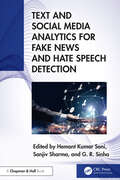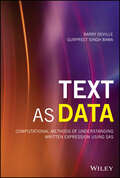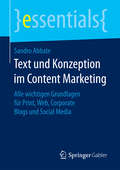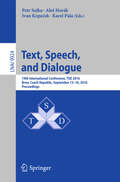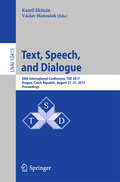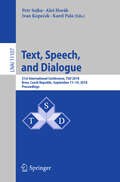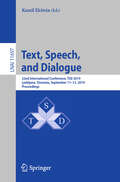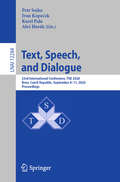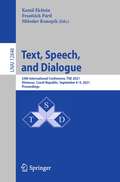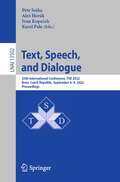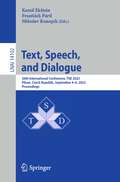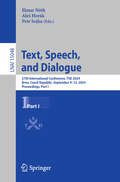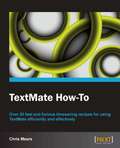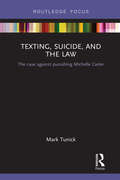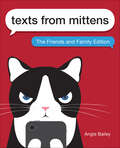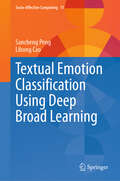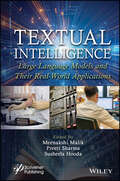- Table View
- List View
Text and Social Media Analytics for Fake News and Hate Speech Detection
by Hemant Kumar Soni, Sanjiv Sharma, and G. R. SinhaIdentifying and stopping the dissemination of fabricated news, hate speech, or deceptive information camouflaged as legitimate news poses a significant technological hurdle. This book presents emergent methodologies and technological approaches of natural language processing through machine learning for counteracting the spread of fake news and hate speech on social media platforms.• Covers various approaches, algorithms, and methodologies for fake news and hate speech detection.• Explains the automatic detection and prevention of fake news and hate speech through paralinguistic clues on social media using artificial intelligence.• Discusses the application of machine learning models to learn linguistic characteristics of hate speech over social media platforms.• Emphasizes the role of multilingual and multimodal processing to detect fake news.• Includes research on different optimization techniques, case studies on the identification, prevention, and social impact of fake news, and GitHub repository links to aid understanding.The text is for professionals and scholars of various disciplines interested in fake news and hate speech detection.
Text as Data: A New Framework for Machine Learning and the Social Sciences
by Justin Grimmer Margaret E. Roberts Brandon M. StewartA guide for using computational text analysis to learn about the social world From social media posts and text messages to digital government documents and archives, researchers are bombarded with a deluge of text reflecting the social world. This textual data gives unprecedented insights into fundamental questions in the social sciences, humanities, and industry. Meanwhile new machine learning tools are rapidly transforming the way science and business are conducted. Text as Data shows how to combine new sources of data, machine learning tools, and social science research design to develop and evaluate new insights.Text as Data is organized around the core tasks in research projects using text—representation, discovery, measurement, prediction, and causal inference. The authors offer a sequential, iterative, and inductive approach to research design. Each research task is presented complete with real-world applications, example methods, and a distinct style of task-focused research.Bridging many divides—computer science and social science, the qualitative and the quantitative, and industry and academia—Text as Data is an ideal resource for anyone wanting to analyze large collections of text in an era when data is abundant and computation is cheap, but the enduring challenges of social science remain.Overview of how to use text as dataResearch design for a world of data delugeExamples from across the social sciences and industry
Text as Data: Computational Methods of Understanding Written Expression Using SAS (Wiley and SAS Business Series)
by Barry DeVille Gurpreet Singh BawaText As Data: Combining qualitative and quantitative algorithms within the SAS system for accurate, effective and understandable text analytics The need for powerful, accurate and increasingly automatic text analysis software in modern information technology has dramatically increased. Fields as diverse as financial management, fraud and cybercrime prevention, Pharmaceutical R&D, social media marketing, customer care, and health services are implementing more comprehensive text-inclusive, analytics strategies. Text as Data: Computational Methods of Understanding Written Expression Using SAS presents an overview of text analytics and the critical role SAS software plays in combining linguistic and quantitative algorithms in the evolution of this dynamic field. Drawing on over two decades of experience in text analytics, authors Barry deVille and Gurpreet Singh Bawa examine the evolution of text mining and cloud-based solutions, and the development of SAS Visual Text Analytics. By integrating quantitative data and textual analysis with advanced computer learning principles, the authors demonstrate the combined advantages of SAS compared to standard approaches, and show how approaching text as qualitative data within a quantitative analytics framework produces more detailed, accurate, and explanatory results. Understand the role of linguistics, machine learning, and multiple data sources in the text analytics workflow Understand how a range of quantitative algorithms and data representations reflect contextual effects to shape meaning and understanding Access online data and code repositories, videos, tutorials, and case studies Learn how SAS extends quantitative algorithms to produce expanded text analytics capabilities Redefine text in terms of data for more accurate analysis This book offers a thorough introduction to the framework and dynamics of text analytics—and the underlying principles at work—and provides an in-depth examination of the interplay between qualitative-linguistic and quantitative, data-driven aspects of data analysis. The treatment begins with a discussion on expression parsing and detection and provides insight into the core principles and practices of text parsing, theme, and topic detection. It includes advanced topics such as contextual effects in numeric and textual data manipulation, fine-tuning text meaning and disambiguation. As the first resource to leverage the power of SAS for text analytics, Text as Data is an essential resource for SAS users and data scientists in any industry or academic application.
Text und Konzeption im Content Marketing: Alle wichtigen Grundlagen für Print, Web, Corporate Blogs und Social Media (essentials)
by Sandro AbbateIn diesem essential erfahren Sie alle wichtigen Grundlagen der Text- und Konzeptentwicklung f#65533;r eine Content-Marketing-Strategie. Der Autor beschreibt die erfolgsentscheidenden Stellschrauben, die Sie beachten m#65533;ssen und in die Sie ausreichend Zeit investieren sollten: von der vorab zu leistenden Denkarbeit, #65533;ber die strukturierte Konzeptentwicklung, bis hin zur optimalen Textarbeit f#65533;r Webtexte. Abgerundet wird dieser Band durch Interviews mit renommierten Experten und Erfolgsbeispielen aus der Praxis.
Text, Speech, and Dialogue
by Petr Sojka Aleš Horák Ivan Kopeček Karel PalaThis volume contains the Proceedings of the 7th International Conference on Text, Speech and Dialogue, held in Brno, Czech Republic, in September 2004, under the auspices of the Masaryk University. This series of international conferences on text, speech and dialogue has come to c- stitute a major forum for presentation and discussion, not only of the latest developments in academic research in these ?elds, but also of practical and industrial applications. Uniquely, these conferences bring together researchers from a very wide area, both intellectually and geographically, including scientists working in speech technology, dialogue systems, text processing, lexicography, and other related ?elds. In recent years the conference has dev- oped into aprimary meetingplacefor speech and languagetechnologistsfrom manydifferent parts of the world and in particular it has enabled important and fruitful exchanges of ideas between Western and Eastern Europe. TSD 2004 offered a rich program of invited talks, tutorials, technical papers and poster sessions, aswellasworkshops andsystemdemonstrations. Atotalof78paperswereaccepted out of 127 submitted, contributed altogether by 190 authors from 26 countries. Our thanks as usual go to the Program Committee members and to the external reviewers for their conscientious and diligent assessment of submissions, and to the authors themselves for their high-quality contributions. We would also like to take this opportunity to express our appreciation to all the members of the Organizing Committee for their tireless efforts in organizing the conference and ensuring its smooth running.
Text, Speech, and Dialogue: 20th International Conference, TSD 2017, Prague, Czech Republic, August 27-31, 2017, Proceedings (Lecture Notes in Computer Science #10415)
by Kamil Ekštein and Václav MatoušekThis book constitutes the proceedings of the 20th International Conference on Text, Speech, and Dialogue, TSD 2017, held in Prague, CzechRepublic, in August 2017.The 56 regular papers presented together with 3 abstracts of keynote talks were carefully reviewed and selected from 117 submissions. They focus on topics such as corpora and language resources; speech recognition; tagging, classification and parsing of text and speech; speech and spoken language generation; semantic processing of text and speech; integrating applications of text and speech processing; automatic dialogue systems; as well as multimodal techniques and modelling.
Text, Speech, and Dialogue: 21st International Conference, TSD 2018, Brno, Czech Republic, September 11-14, 2018, Proceedings (Lecture Notes in Computer Science #11107)
by Petr Sojka Aleš Horák Ivan Kopeček Karel PalaThis book constitutes the refereed proceedings of the 21st International Conference on Text, Speech, and Dialogue, TSD 2018, held in Brno, Czech Republic, in September 2018. The 56 regular papers were carefully reviewed and selected from numerous submissions. They focus on topics such as corpora and language resources, speech recognition, tagging, classification and parsing of text and speech, speech and spoken language generation, semantic processing of text and search, integrating applications of text and speech processing, machine translation, automatic dialogue systems, multimodal techniques and modeling.
Text, Speech, and Dialogue: 22nd International Conference, TSD 2019, Ljubljana, Slovenia, September 11–13, 2019, Proceedings (Lecture Notes in Computer Science #11697)
by Kamil EkšteinThis book constitutes the proceedings of the 22nd International Conference on Text, Speech, and Dialogue, TSD 2019, held in Ljubljana, Slovenia, in September 2019. The 33 full papers presented in this volume were carefully reviewed and selected from 73 submissions. They were organized in topical sections named text and speech. The book also contains one invited talk in full paper length.
Text, Speech, and Dialogue: 23rd International Conference, TSD 2020, Brno, Czech Republic, September 8–11, 2020, Proceedings (Lecture Notes in Computer Science #12284)
by Petr Sojka Aleš Horák Ivan Kopeček Karel PalaThis book constitutes the proceedings of the 23rd International Conference on Text, Speech, and Dialogue, TSD 2020, held in Brno, Czech Republic, in September 2020.*The 54 full papers presented in this volume were carefully reviewed and selected from 110 submissions. They were organized in topical sections named text, speech, and dialogue. The book also contains 3 invited talks.* The conference was held virtually due to the COVID-19 pandemic.
Text, Speech, and Dialogue: 24th International Conference, TSD 2021, Olomouc, Czech Republic, September 6–9, 2021, Proceedings (Lecture Notes in Computer Science #12848)
by Kamil Ekštein František Pártl Miloslav KonopíkThis book constitutes the proceedings of the 24th International Conference on Text, Speech, and Dialogue, TSD 2021, held in Olomouc, Czech Republic, in September 2021.*The 2 keynote speeches and 46 papers presented in this volume were carefully reviewed and selected from 101 submissions. The topical sections "Text", "Speech", and "Dialogue" deal with the following issues: speech recognition; corpora and language resources; speech and spoken language generation; tagging, classification and parsing of text and speech; semantic processing of text and speech; integrating applications of text and speech processing; automatic dialogue systems; multimodal techniques and modelling, and others. * Due to the COVID-19 pandemic the conference was held in a "hybrid" mode.
Text, Speech, and Dialogue: 25th International Conference, TSD 2022, Brno, Czech Republic, September 6–9, 2022, Proceedings (Lecture Notes in Computer Science #13502)
by Petr Sojka Aleš Horák Ivan Kopeček Karel PalaThis book constitutes the proceedings of the 25th International Conference on Text, Speech, and Dialogue, TSD 2022, held in Brno, Czech Republic, in September 2022. The 43 papers presented in this volume were carefully reviewed and selected from 94 submissions. The topical sections "Text", "Speech", and "Dialogue" deal with the following issues: speech recognition; corpora and language resources; speech and spoken language generation; tagging, classification and parsing of text and speech; semantic processing of text and speech; integrating applications of text and speech processing; automatic dialogue systems; multimodal techniques and modelling.
Text, Speech, and Dialogue: 26th International Conference, TSD 2023, Pilsen, Czech Republic, September 4–6, 2023, Proceedings (Lecture Notes in Computer Science #14102)
by Kamil Ekštein František Pártl Miloslav KonopíkThis book constitutes the refereed proceedings of the 26th International Conference on Text, Speech, and Dialogue, TSD 2023, held in Pilsen, Czech Republic, during September 4–6, 2023. The 31 full papers presented together with the abstracts of 3 keynote talks were carefully reviewed and selected from 64 submissions. The conference attracts researchers not only from Central and Eastern Europe but also from other parts of the world. One of its goals has always been bringing together NLP researchers with various interests from different parts of the world and promoting their cooperation. One of the ambitions of the conference is, not only to deal with dialogue systems but also to improve dialogue among researchers in areas of NLP, i.e., among the “text” and the “speech” and the “dialogue” people.
Text, Speech, and Dialogue: 27th International Conference, TSD 2024, Brno, Czech Republic, September 9–13, 2024, Proceedings, Part I (Lecture Notes in Computer Science #15048)
by Petr Sojka Aleš Horák Elmar NöthThe two-volume set LNAI 15048 and 15049 constitutes the refereed proceedings of the 27th International Conference on Text, Speech, and Dialogue, TSD 2024, held in Brno, Czech Republic, during September 9–13, 2024. The 50 revised full papers presented in these deadline proceedings were carefully reviewed and selected from 103 submissions. The papers are organized in the following topical sections: Part I: Text Part II: Speech, Dialogue
Text, Speech, and Dialogue: 27th International Conference, TSD 2024, Brno, Czech Republic, September 9–13, 2024, Proceedings, Part II (Lecture Notes in Computer Science #15049)
by Petr Sojka Aleš Horák Elmar NöthThe two-volume set LNAI 15048 and 15049 constitutes the refereed proceedings of the 27th International Conference on Text, Speech, and Dialogue, TSD 2024, held in Brno, Czech Republic, during September 9–13, 2024. The 50 revised full papers presented in these deadline proceedings were carefully reviewed and selected from 103 submissions. The papers are organized in the following topical sections: Part I: Text Part II: Speech, Dialogue
Text, Speech, and Dialogue: 28th International Conference, TSD 2025, Erlangen, Germany, August 25–28, 2025, Proceedings, Part I (Lecture Notes in Computer Science #16029)
by Kamil Ekštein František Pártl Miloslav Konopík Ondřej PražákThis conference volume constitutes the proceedings of the 28th International Conference on Engineering on Text, Speech, and Dialogue, TSD 2025, held in Erlangen, Germany, in August 2025. The 60 full papers were presented in this volume were carefully reviewed and selected from 122 submissions. They focus on speech and language technologies and computer processing of speech and language related data.
Text, Speech, and Dialogue: 28th International Conference, TSD 2025, Erlangen, Germany, August 25–28, 2025, Proceedings, Part II (Lecture Notes in Computer Science #16030)
by Kamil Ekštein František Pártl Miloslav Konopík Ondřej PražákThis conference volume constitutes the proceedings of the 28th International Conference on Engineering on Text, Speech, and Dialogue, TSD 2025, held in Erlangen, Germany, in August 2025. The 60 full papers were presented in this volume were carefully reviewed and selected from 122 submissions. They focus on speech and language technologies and computer processing of speech and language related data.
TextMate How-to
by Chris Mears"TextMate How-to" address essential tasks through recipes to hit the ground running and get started with practical solutions to common questions This book is geared toward beginning and intermediate web developers and designers who want to expedite their coding. Though TextMate can also work very well as a plain text editor, some experience with a programming or scripting language whether it's HTML, CSS, PHP, or Ruby is helpful to understand the depth to some of the examples provided.
Texten mit ChatGPT: Einfach, schnell und kreativ: Ideenmaschine für Kommunikation, Marketing, Werbung und PR
by Albert HeiserIn diesem Buch zeigt Albert Heiser – mehrfach ausgezeichneter Werbetexter – wie GPT-Programme zur Entwicklung wirkungsvoller und auch kreativer Texte in Werbung, Marketing und Kommunikation genutzt werden können. Texten mit Chatbots ist nicht neu, aber können GPT-Programme auch kreative und ansprechende Texte für Marketing, Werbung und Unternehmenskommunikation erstellen? Der Autor hat dies umfassend mit ChatGPT getestet und ebenfalls mit Neuroflash, Perplexity und Gemini verglichen. In seinem Buch zeigt er anhand der vielfältigen Textstrukturen im Marketing (von der Headline bis zum Call to Action), wie Chatbots als Brainstorming-Partner genutzt werden können. Zudem vermittelt er klare Qualitätskriterien für die Beurteilung von Texten – Kriterien, mit denen zielsicher Korrekturen an den KI-Texten gelingen. Das Verständnis für einen guten Schreibstil und die Wirkung der Gestaltung stehen dabei im Mittelpunkt. Dieses Buch bietet einen stilistischen Qualitäts- und Kreativcheck sowie eine Anleitung zum Prompten für Werbung, Marketing und Kommunikation, wie zum Beispiel für Headlines, Zwischenüberschriften, Imagetexte, Anzeigentexte, Produktbeschreibungen, Broschüren, Flyer, Mailings, Newsletter, Blogbeiträge, Social-Media-Posts, Teaser-Texte, Banner, Internetseiten und PR-Mitteilungen. Damit werden GPT-Programme zu einem wirkungsvollen Tool im Werkzeugkasten von Werbetextern, Autoren, Redakteuren und Content Managern. Der Inhalt So funktionieren GPT-Programme – darauf muss man achten Prompt-Engineering für Marketing, Werbung und Kommunikation: von der Headline bis zum Call to Action Prompts für längere Texte: von der Einleitung bis zum Fazit Die stilistische Qualität der Texte mit GPT prüfen und optimieren Der kreative Prompt Aktueller Stand zu Urheber- und Nutzungsrechten
Texting, Suicide, and the Law: The case against punishing Michelle Carter
by Mark TunickIn 2014, Conrad Roy committed suicide following encouragement from his long-distance girlfriend, Michelle Carter, in what has become known as the Texting Suicide case. The case has attracted much attention, largely focusing on the First Amendment free speech issue. This book takes the view that the issue is intertwined with several others, some of which have received less attention but help explain why the case is so captivating and important, issues concerning privacy, accountability, coercion, punishment, and assisted suicide. The focus here is on how all of these issues are interconnected. By breaking the issue down into its complex layers, the work aids reasoned judgment, ensuring we aren’t guided solely by our gut reactions. The book is laid out as a case against punishing Ms. Carter, but it is less important that we agree with that conclusion than that we reach our conclusions not just through our instincts and intuitions but by thinking about these fundamental issues. The work will be of interest to scholars in law, political theory, and philosophy as an example of how theoretical issues apply to particular controversies. It will also appeal to readers interested in freedom of speech and the First Amendment, criminal justice and theories of punishment, suicide laws, and privacy.
Texts from Mittens
by Angie BaileyFollow along with Mittens as he enjoys hilarious, snark-filled text volleys with his cast of quirky friends and family: Earl (the &“filthy hound&”), Stumpy (the best friend), Drunky Patty (the usually tipsy next-door neighbor), Grandma (giver of treats), and Fiona (Mitty&’s girlfriend). Based on Angie Bailey&’s virally popular blog, Texts from Mittens: The Friends and Family Edition is feline humor at its finest.
Textual Cacophony: Online Video and Anonymity in Japan
by Daniel JohnsonTextual Cacophony explores the behaviors and routines of communication within anonymous internet culture in Japan. Focusing on the video sharing website Niconico, social media aggregation sites, and the notorious 2channel message board, Daniel Johnson uncovers these sites' complex cultures of writing that obscure meaning through playful and opaque forms of deviant script and overwhelming waves of text. Those practices conflate language with images, meaning with play, and confound individual representation with aggregate forms of social identity. Johnson argues that online media cultures in and around Japan are entwined with a cultural logic and visual syntax of cacophony that expresses ambivalence toward representation, media form, and distinct experiences of time. This aesthetic of cacophony provides an alternative way of expressing social identity and belonging, with an unmarked sense of anonymity providing a counter-form to the dissolving institutions and relationships of neoliberal Japan. Textual Cacophony investigates what it means and feels like to participate in this influential online culture.
Textual Data Science with R (Chapman & Hall/CRC Computer Science & Data Analysis)
by Mónica Bécue-BertautTextual Statistics with R comprehensively covers the main multidimensional methods in textual statistics supported by a specially-written package in R. Methods discussed include correspondence analysis, clustering, and multiple factor analysis for contigency tables. Each method is illuminated by applications. The book is aimed at researchers and students in statistics, social sciences, hiistory, literature and linguistics. The book will be of interest to anyone from practitioners needing to extract information from texts to students in the field of massive data, where the ability to process textual data is becoming essential.
Textual Emotion Classification Using Deep Broad Learning (Socio-Affective Computing #11)
by Sancheng Peng Lihong CaoIn this book, the authors systematically and comprehensively discuss textual emotion classification by using deep broad learning. Since broad learning possesses certain advantages such as simple network structure, short training time and strong generalization ability, it is a new and promising framework for textual emotion classification in artificial intelligence. As a result, how to combine deep and broad learning has become a new trend of textual emotion classification, a booming topic in both academia and industry. For a better understanding, both quantitative and qualitative results are present in figures, tables, or other suitable formats to give the readers the broad picture of this topic along with unique insights of common sense and technical details, and to pave a solid ground for their forthcoming research or industry applications. In a progressive manner, the readers will gain exclusive knowledge in textual emotion classification using deep broad learning and be inspired to further investigate this underexplored domain. With no other similar book existing in the literature, the authors aim to make the book self-contained for newcomers, only a few prerequisites being expected from the readers. The book is meant as a reference for senior undergraduates, postgraduates, scientists and researchers interested to have a quick idea of the foundations and research progress of security and privacy in federated learning, and it can equally well be used as a textbook by lecturers, tutors, and undergraduates.
Textual Information Access: Statistical Models (Wiley-iste Ser. #588)
by Eric Gaussier François YvonThis book presents statistical models that have recently been developed within several research communities to access information contained in text collections. The problems considered are linked to applications aiming at facilitating information access: - information extraction and retrieval; - text classification and clustering; - opinion mining; - comprehension aids (automatic summarization, machine translation, visualization). In order to give the reader as complete a description as possible, the focus is placed on the probability models used in the applications concerned, by highlighting the relationship between models and applications and by illustrating the behavior of each model on real collections. Textual Information Access is organized around four themes: informational retrieval and ranking models, classification and clustering (regression logistics, kernel methods, Markov fields, etc.), multilingualism and machine translation, and emerging applications such as information exploration. Contents Part 1: Information Retrieval 1. Probabilistic Models for Information Retrieval, Stéphane Clinchant and Eric Gaussier. 2. Learnable Ranking Models for Automatic Text Summarization and Information Retrieval, Massih-Réza Amini, David Buffoni, Patrick Gallinari, Tuong Vinh Truong and Nicolas Usunier. Part 2: Classification and Clustering 3. Logistic Regression and Text Classification, Sujeevan Aseervatham, Eric Gaussier, Anestis Antoniadis, Michel Burlet and Yves Denneulin. 4. Kernel Methods for Textual Information Access, Jean-Michel Renders. 5. Topic-Based Generative Models for Text Information Access, Jean-Cédric Chappelier. 6. Conditional Random Fields for Information Extraction, Isabelle Tellier and Marc Tommasi. Part 3: Multilingualism 7. Statistical Methods for Machine Translation, Alexandre Allauzen and François Yvon. Part 4: Emerging Applications 8. Information Mining: Methods and Interfaces for Accessing Complex Information, Josiane Mothe, Kurt Englmeier and Fionn Murtagh. 9. Opinion Detection as a Topic Classification Problem, Juan-Manuel Torres-Moreno, Marc El-Bèze, Patrice Bellot and Fréderic Béchet.
Textual Intelligence: Large Language Models and Their Real-World Applications
by Susheela Hooda Meenakshi Malik Preeti SharmaThe book is a must-have resource for anyone looking to understand the complexities of generative AI, offering comprehensive insights into LLMs, effective training strategies, and practical applications. Textual Intelligence: Large Language Models and Their Real-World Applications provides an overview of generative AI and its multifaceted applications, as well as the significance and potential of Large Language Models (LLMs), including GPT and LLaMA. It addresses the generative AI project lifecycle, challenges in existing data architectures, proposed use case planning and scope definition, model deployment, and application integration. Training LLMs, data requirements for effective LLM training, pre-training and fine-tuning processes, and navigating computational resources and infrastructure are also discussed. The volume delves into in-context learning and prompt engineering, offering strategies for crafting effective prompts, techniques for controlling model behavior and output quality, and best practices for prompt engineering. Textual Intelligence: Large Language Models and Their Real-World Applications also discusses cost optimization strategies for LLM training, aligning models to human values, optimizing model architectures, the power of transfer learning and fine-tuning, instruction fine-tuning for precision, and parameter-efficient fine-tuning (PEFT) with adapters such as LoRA, QLoRA, and soft prompts, making it an essential guide for both beginners and industry veterans. Readers will find this book: Explores the real-world potential of large language models; Introduces industry-changing AI solutions; Provides advanced insights on AI and its models. Audience Industry professionals, academics, graduate students, and researchers seeking real-world solutions using generative AI.
